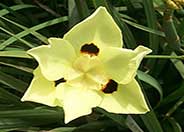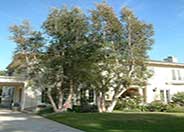
Common name:Yellow Moraea, Fortnight Lily
Botanical name:Dietes bicolor
This clumping perennial Iris relative stands 3'-4' high. It has light yellow, iris-like flowers with maroon blotches that are about 2" wide. It performs best in full sun and in soil with good drainage.

Common name:Star Jasmine, Maile Haole
Botanical name:Trachelospermum jasminoides
Star Jasmine is an evergreen vine that grows 20' tall or a ground cover that reaches 1'-2' tall and 4'-5' wide. It has white fragrant flowers in the summer and can tolerate sun or partial shade. The star jasmine needs regular watering. Leaves are dark green, oval, thick, about 2" long. This is a great plant on a trellis, in containers or in a parking strip.

Common name:Petunia
Botanical name:Petunia X hybrida
This plant will grow 1'-3' tall and has medium-sized green leaves with multi-colored flowers that bloom in spring and summer.

Common name:Sweet Orange cultivars
Botanical name:Citrus sinensis
This tree will grow 20'-30' high and 10'-15' wide; it produces sweet, tasty oranges. It has shiny green, leathery foliage and produces clusters of fragrant white flowers that bloom in the spring.

Common name:Japanese Boxwood
Botanical name:Buxus microphylla japonica
Japanese Boxwood is often used as a hedge. It is compact, with small bright green leaves. It can reach 4'-6' tall and wide or be kept smaller through pruning. It can be sheared to shape. It does better in areas with milder winters.

Common name:Paperbark Tree, Cajeput Tree
Botanical name:Melaleuca quinquenervia
Paperbark or Cajeput (Melaleuca quinquenervia) is an Australian native that is known for its beautiful, papery bark that unravels in sheets on the trunk. The tree can reach 40’ tall and 15’-25’ wide. It is often grown as a multi-trunk tree, and it makes a beautiful specimen tree in a wide range of garden styles. It is unparticular about its soil, and it can thrive in a wide range of moisture conditions. If this tree is selected for a small- to medium-sized garden, measures must be taken to keep topical roots from forming. Drip irrigation or deep, infrequent watering is best. If this tree is planted near an area with overhead sprinklers, root barriers may be necessary to keep roots away from the wetter parts of the garden. Once the tree reaches a size where it could benefit from some shaping, it is best to have a licensed arborist perform the work. This tree should be planted at least eight feet away from any hardscape areas, 15 feet from structures such as houses and buildings, and not near any powerlines. Shrubs and perennials should be planted about five feet away from this tree. It should be irrigated for about 45 minutes once a week when using most in-line drip irrigation systems.
Designer: N/A
Photographer: GardenSoft
Physical weed control, including mulching, or hand removal protects the watershed from harmful chemicals.
Adjust sprinklers to avoid watering sidewalks and driveways.
Remove irrigation water and fertilizer from areas where you don't want weeds to grow.